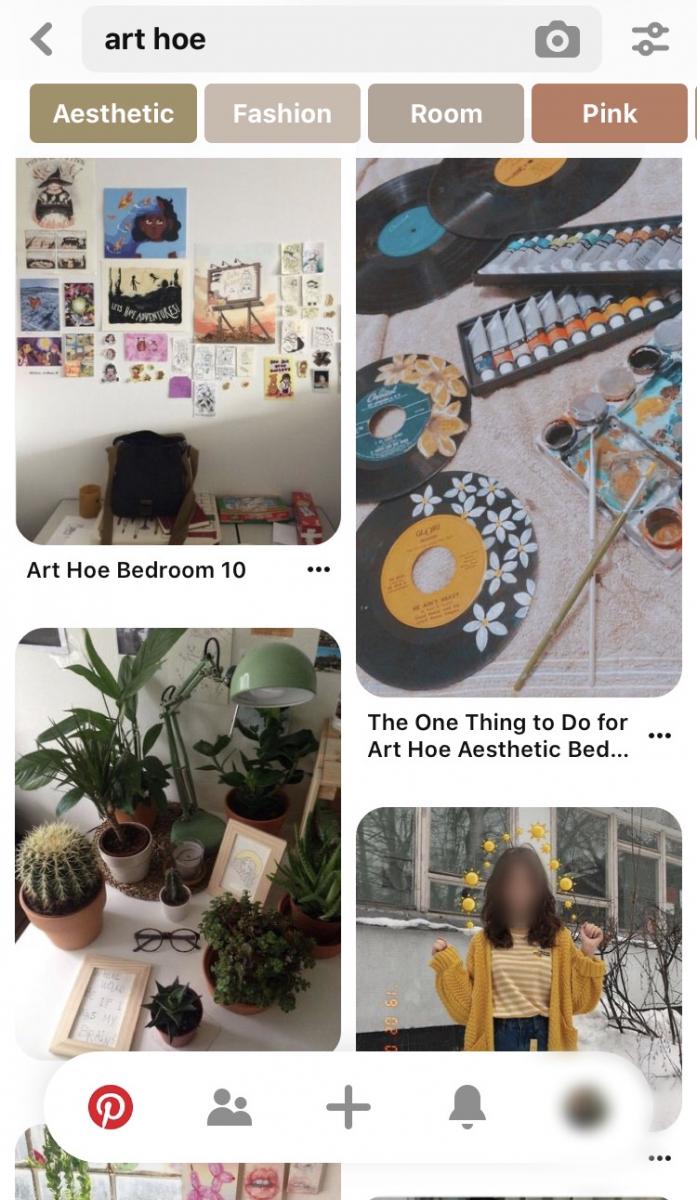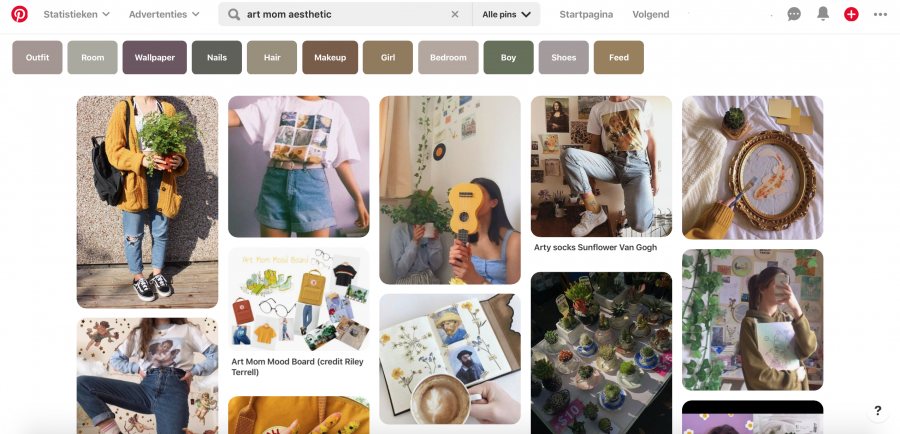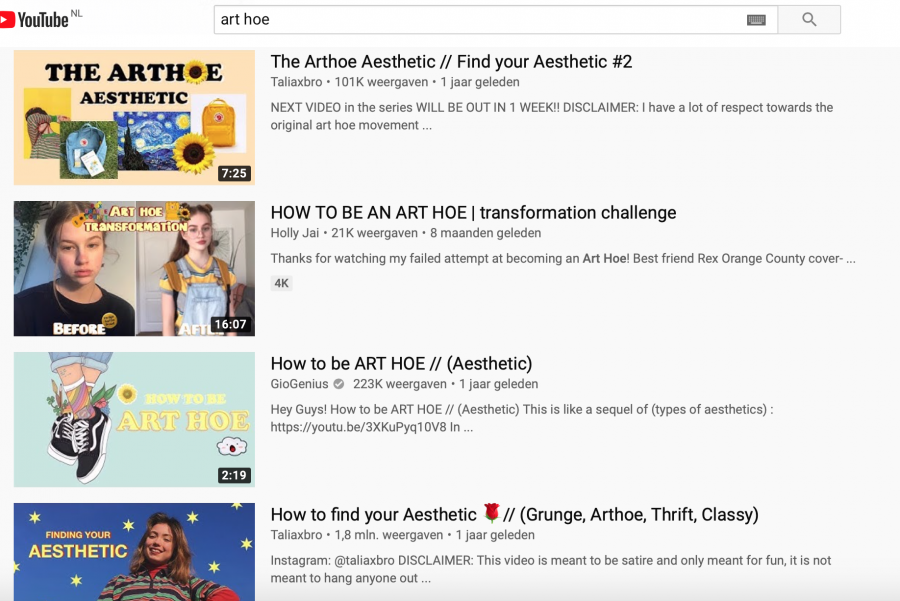
The whitewashing of the 'art hoe' movement
This article explores how the art hoe movement, meant as a space of creative expression for PoC (People of Colour) artists, got whitewashed into a mere aesthetic disconnected from its origins.
What's an 'art hoe'?
'Art hoe' is a term that can be found on platforms like Instagram, Tumblr, and Pinterest. A quick search across social media platforms seems to reveal a lot about what exactly an ‘art hoe’ is supposed to be. Most results from such a search immediately reveal the material conditions that define being an art hoe. To be an art hoe is to own a Fjallraven Kanken bag and/or to own some socks with popular artwork on them.
It’s only after further exploration that the origins of this movement become clear: it's a movement that was started by and for PoC artists. When entering '#arthoe' into Instagram or Tumblr's search engines, however, one finds that the majority of pictures are posted by white girls and display completely different characteristics than those of the original movement. But what are the original characteristics? How did this art hoe movement start, and how come it now seems so disconnected from its origins?
The start
To fully understand the movement, we need to look at its origins. The movement started at the beginning of 2015, and it comprised a few Tumblr users. One of the co-founders is Mars, a 16-year-old genderfluid, PoC Tumblr user. Mars and the other co-founders started drawing on their selfies. They didn’t mean much by it; these were just some fun drawings to make their selfies more interesting. This was until Jam, also a PoC Tumblr user, reached out to them. Jam brought to them the idea that something had started with this practice of drawing on one's selfie. This selfie was no longer just a picture of themselves; by drawing on it, users had turned it into a form of creative expression. The selfie was not only about the perception of themselves, but 'also a possible creative outlet to shatter gender, class and race glass ceilings'. In this movement, the concept of the selfie, often perceived as something rather shallow, vain, and self-centred, is transformed into a powerful statement about how you can control how you want to be perceived. This is how an artistic selfie evolved into a movement. It's not just the art, nor the message, but the combination of these that makes the movement so powerful.
It's not just the art, nor the message, but the combination of these that makes the movement so powerful.
The term 'art hoe' was first coined by rapper Babeo, and carefully chosen by Mars and Jam. While some still argue it's an offensive term, for Mars and Jam that is precisely where its power lies: in reclaiming an offensive term used against you, and using that word to empower yourself. Black people have since reclaimed the term 'hoe' (or 'ho'). In an interview, Mars explains how the term ties together all the main themes of the movement, such as identity, gender, and visual art.
Jam elaborates on this in a Tumblr post stating that 'the Art Hoe movement is all about true creative freedom for PoC, especially black women'. Art has always been a space generally occupied by white, straight, and cisgender people. While in our modern times more and more attention is paid to diversity and equal opportunities in art, there's still a long way to go. Therefore, they say this movement is important to give space to PoC artists (later QPoC, Queer and/or PoC artists) to express their creativity and claim their space in art. Characteristics belonging to this movement include creatively edited, drawn-on selfies, bright colours, and black style expression. These features relate to the issues of creativity, power, standing out, and taking control over how PoC are viewed by others. Crucially, they all serve the ultimate goal of claiming a space for PoC artistic expression.
Development through social media
The art hoe movement was created online and exists online, therefore social media networks are the main medium for its spread.The search term 'art hoe' on Google steadily increased in popularity since 2015.

The amount of google searches for "art hoe" over the years.
Famous people who have added their contribution to the movement include Willow Smith, a PoC actress and singer, and Amandla Stenberg, a PoC and non-binary actress. Their contributions have helped increase the movement's popularity and its reach. Many (young) PoC artists also found a place for expressing themselves and presenting their work within this movement as the founders started the Instagram page @arthoecollective to feature artworks by QPoC artists, helping them get more recognition.
The movement today
However, typing in the term 'art hoe' for example on Pinterest nowadays seems to show something completely different than PoC artists empowering themselves. Such a search brings up an entirely different set of features: the pictures and posts show lots of paint, art, plants, and famous artworks. These pictures don't seem to reveal much about the movement and its origins described above. These specific characteristics now seem to be part of an aesthetic labelled 'art hoe'. While this aesthetic is somehow connected to the term, it is not the same as the original movement.

Results for 'art hoe' on Pinterest.
To explore the difference between the original art hoe movement and this current general aesthetic as well as people's perception of the term 'art hoe', I decided to ask some followers of this Instagram account what they think of when they hear the term 'art hoe'. This account would be considered an 'art hoe' account according to the new aesthetic criteria. My aim was to see whether users associated the term with this new aesthetic or with its original meaning.
The majority of followers asked mentioned the aesthetic's characteristics: the colour yellow, the famous bags, paintings, van Gogh, a certain clothing style (wearing colourful, 80's style clothes), and, not unimportantly, being artsy. There were also responses citing the account from which this was asked as the perceived essence of art hoe, even though the owner is not a PoC. The interesting thing here is that only a handful of people mention knowing something about the roots of the movement, mentioning the history of @arthoecollective or mentioning it's a PoC movement. With the majority merely mentioning aesthetic characteristics, these findings further show that this movement got very disconnected from its roots.
A few responses to the question "what do you think of when you think of 'art hoe'?"
What's also noticeable here is that the characteristics mentioned seem very similar to characteristics belonging to an aesthetic referred to as 'art mom' or 'plant mom'. Searching these terms on Instagram, Pinterest, and Tumblr reveals these same characteristics, such as the Fjallraven backpacks, plants, being artsy, and wearing mom jeans. It seems as if these are similar aesthetics labelled under different names, and 'art hoe' covers this aesthetic as well. The fact that this particular micro-community can be labelled under different names reveals that the name is not the most important part of the aesthetic as other names seem to be used as well.

Pinterest search results for 'art mom aesthetic'
A shift in meaning and characteristics
Now that the history of both meanings of the term has been examined, let us look at the shift in meaning and characteristics between the original meaning of 'art hoe' (referred to as a 'movement') and the new meaning (referred to as an 'aesthetic').
If we look at the notion of enoughness, i.e. having enough identity emblems to be recognised as a member of the group (Blommaert & Varis, 2015), a big difference emerges. For the aesthetic, just being artsy doesn't seem to be enough to be recognised as an 'art hoe'; not everyone who is into and makes art would be seen as an art hoe. More characteristics are needed for someone to be 'enough' to be seen as part of this aesthetic.
There's plenty of videos to be found online which explain 'how to be an art hoe'. These videos show the common norms for constructing this aesthetic. In this case, material characteristics are important. To be seen as a full member of this aesthetic group, besides being artsy, you need at least some of the material characteristics mentioned. This is in contrast to the terms of enoughness in regard to the original movement. Being a PoC artist and posting selfies purposefully edited in an artsy and creative way to express power is enough to be recognised as a follower of the movement, but not enough to be recognised as a member of the art hoe aesthetic. In this way, the aesthetic is more exclusive because more wealth is needed to be seen as enough, which is in contrast with the movement, where wealth does not matter.

YouTube tutorials showing the norms of the art hoe aesthetic.
Another remarkable difference is that the aesthetic is more centred towards homogeneity. Because the material conditions for being an art hoe in this sense are very persistent, the majority of the aesthetic followers own the same items. Of course, there is a certain search for authenticity as not everyone can be exactly the same, but the general principles of the script these followers adhere to appear homogeneously. For example, someone can stand out in terms of their clothing style, but if they stand out too much they will no longer be recognised as embodying the art hoe aesthetic. That is, in the aesthetic's terms, there is limited room for variation within the behavioral script for being seen as an art hoe. It is in this regard that the aesthetic now differs profoundly from the original ideas of the art hoe movement, which was all about art, and therefore about creativity and originality. For the movement, there are no material conditions that need to be met. In this sense, the movement was and is more focussed on heterogeneity.
Cultural appropriation
Now that we've talked about the history and development of the art hoe movement, it's time to look at the divergence between the movement's original message and what we witness today. Taking over elements of a culture, especially taking them from a minority group, and placing them out of their cultural context falls under the notion of cultural appropriation. This case aligns with this definition: the name of the movement got taken over, out of its original context, and away from people of colour, the minority group that started the cultural movement. This cultural appropriation only emphasises the need for the art hoe movement in the first place, because this new aesthetic carrying the name 'art hoe' overrules PoC in art again.
This cultural appropriation only emphasises the need for the art hoe movement in the first place, because this new aesthetic carrying the name 'art hoe' overrules PoC in art again.
In their interview, Mars emphasised how the new 'art hoe' aesthetic contains lots of (expensive) material expressions, like expensive bags and cameras. This counters the original idea of the movement, which was about creativity, not wealth. Making art hoe about wealth is a another shift that aligns with the idea of cultural appropriation. Not everyone can afford these materials and many are therefore excluded from this aesthetic. This results in a powerful group, wealthy people, overruling a less powerful group, less wealthy people, in this aesthetic. This, again, points to the phenomenon of cultural appropriation.
@arthoecollective
The founders of the movement acknowledge the appropriation and hope to take back the power of the movement. This was a reason for them to start the @arthoecollective Instagram account: 'What we’re hoping to do with [@arthoecollective], is reclaim the movement that has been somewhat stolen from us with White girls, kanken backpacks and expensive markers.' (founder Jam). Some potential for overcoming this issue lies in the fact that the aesthetic referred to as 'art hoe' carries multiple names which are all connected to this same aesthetic, as mentioned above: terms like 'art mom' or 'plant mom' can be used just as well. In this there's the possibility of using those terms for the aesthetic and restoring the term 'art hoe' to its original meaning.
Since people seem generally unaware of the origins of 'art hoe' as a term and as a movement, more awareness is needed. If users become familiar with the original meaning and spread the movement's message, the aesthetic's followers can switch to using other terms. This seems like a long way to go for such an often-used term, but awareness can spread incredibly fast online if the right actions are taken. With the right mobilization, the term 'art hoe' can be restored to its original meaning, and the movement's message can be spread fast, loud and clear.
References
Blommaert, J. & Varis, P. (2015). Enough is enough: the heuristics of authenticity in superdiversity. In J. Blommaert & P. Varis, Enoughness, accent and light communities: Essays on contemporary identities (pp. 4–15). Tilburg papers in Culture Studies 139.